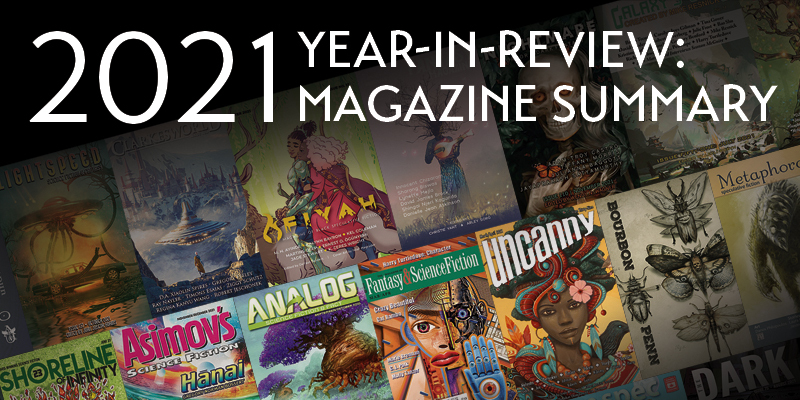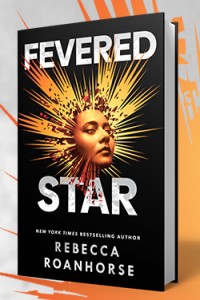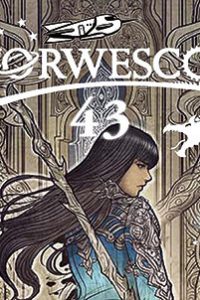Year-in-Review: 2021 Magazine Summary
Year Two in the Time of COVID: We saw surprising resilience this year on the magazine front. There are a number of mags for whom we expanded entries and several new additions, although there were still a few that dropped out of print and at least one false start. We asked publishers which Hugo Award category they qualify for or used the data from <semiprozine.org> or our best determination; the information provided this year (or last year) is in brackets at the end of each write up. Any of the editors or publishers named would generally be eligible for Best Editor, Short Form, and the non-fiction magazines would generally be eligible for Related Work.
For the purposes of the Magazine Summary, the genre magazines are primarily sorted by Hugo Eligibility: Professional, Semiprozine, etc., and then loosely by pay rate, SFWA qualifying market, and the amount of fiction published. We covered 81 magazines, 16 audio sites, and 10 critical magazines.
In our charts we use the Statement of Ownership, required for use of a USPS Periodical Permit, plus numbers as provided, to get subscriber and newsstand sales for those who generate them, though this becomes less meaningful with digital numbers on the rise. Print-plus-digital circulation figures for Analog, Asimov’s, and Locus wrapped in the subscription numbers, keeping sell-through number just for print (since there are no digital returns). There is no digital circulation information from F&SF.
PROFESSIONAL MAGAZINES
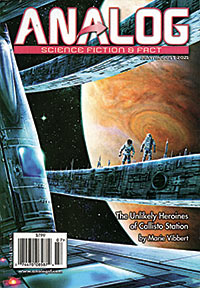 Analog, <www.analogsf.com>, had 8,901 average print subscriptions per month and 9,233 digital, tipping the scales toward electronic, for a total of 18,134, down just a touch from last year’s 18,275. Newsstand sales were 2,753, up from 2,098. Paid circulation was up 2.5%; sell-through was 49%, up from last year’s 37% and almost nailing the traditional ideal of 50%.
Analog, <www.analogsf.com>, had 8,901 average print subscriptions per month and 9,233 digital, tipping the scales toward electronic, for a total of 18,134, down just a touch from last year’s 18,275. Newsstand sales were 2,753, up from 2,098. Paid circulation was up 2.5%; sell-through was 49%, up from last year’s 37% and almost nailing the traditional ideal of 50%.
Analog produced six tall, digest-size double issues with 208 pages each. Cover price was $7.99. There were four novellas, 20 novelettes, 63 short stories, and one serial, for a total of 88 pieces of fiction, down from last year’s 94, plus six ‘‘Science Fact’’ pieces, seven pieces of flash fiction, and 12 poems. Covers, sporting an updated logo, were colorful throughout the year, including an underwater scene of a woman facing a giant squid, two astronauts spacewalking on the rings of a space station, and some unusual but charming and ambulatory purple tree-forms on a hillside. Editor Trevor Quachri said, ‘‘We’ve weathered another year of the pandemic well, with a steady stream of new authors and favorite pros appearing each issue. We closed our old office earlier this year, and we’ll be opening in a new space early in 2022. The refreshed logo looks great and was received well, and we kicked off the first annual Analog Award for Emerging Black Voices, which we’ll be announcing the winner of shortly. We look forward to mentoring the winner in the upcoming year and continuing to get the word out about the next round of submissions. Trevor recently recorded an episode of the Unknown Worlds of the Merril Collection podcast with its hosts, and we’ll be participating in the sixth annual City Tech Science Fiction Symposium very soon (though no doubt in the past by the time readers see this).’’ Analog paid 8-10 cents per word for short fiction, and 6 cents per word for serials. [Professional]
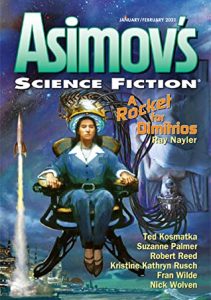 Asimov’s, <www.asimovs.com>, had 6,108 print subscriptions and 10,202 digital subscriptions for a total of 16,310, down slightly from 16,643 last year. Newsstand sales were 2,373, up from 2,076, with 44% sell-through, up from last year’s 39%. Total paid circulation was mostly flat: down 0.2%.
Asimov’s, <www.asimovs.com>, had 6,108 print subscriptions and 10,202 digital subscriptions for a total of 16,310, down slightly from 16,643 last year. Newsstand sales were 2,373, up from 2,076, with 44% sell-through, up from last year’s 39%. Total paid circulation was mostly flat: down 0.2%.
Asimov’s produced six tall, digest-size double issues with 208 pages each. There were 8 novellas, 26 novelettes, 35 short stories, and no reprints, for 69 pieces of fiction, up from 67 last year, plus 29 poems. Cover price was $7.99. Nice quality covers ranged from a woman diving with an armored sea creature, to spacescapes, to two people connected by cybernetic helmets with a futuristic background. Editor Sheila Williams said, ‘‘Despite coping with the pandemic, Asimov’s and other magazines had another good year. It was a relief and a joy to see the bookstores reopening as this meant we experienced no interruptions in newsstand sales. Although we’ve been working full time from home for a year and three fourths, we, like others in the workforce, are moving to a hybrid situation. I’m looking forward to meeting with Emily Hockaday and our part-time assistant in an office space and once again having the use of an industrial photo copier! In 2021 we published amazing stories by more people than I can name. Too briefly, these include Greg Egan, Elizabeth Bear, Rick Wilber, Ray Nayler, Gregory Norman Bossert, Leah Cypess, Wole Talabi, Michael Swanwick, Fran Wilde, Jack McDevitt, Kristine Kathryn Rusch, Jason Sanford, S. Qiouyi Lu, Nick Wolven, Megan Lindholm, and Will McIntosh. We were proud, yet very sad, to publish the final works by Grand Master James Gunn and we were pleased to welcome brand new voices into the magazine. As I’ve already laid out the first few 2022 issues, I know that we have some very exciting work in the pipeline!’’ Asimov’s paid 8-10 cents per word for short stories up to 7,500 words, and 8 cents for each word over 7,500. [Professional]
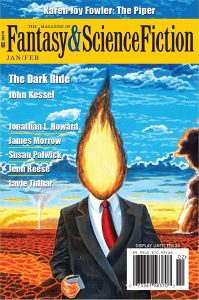 F&SF, <www.fandsf.com>, showed print subscription numbers of 5,112 in its Statement of Ownership, down a little from 5,257 the prior year, with 956 copies sold on newsstands and sell-through of 36%. Paid circulation was down 4.9%. As always, without digital figures available it’s difficult to say how well the magazine did overall.
F&SF, <www.fandsf.com>, showed print subscription numbers of 5,112 in its Statement of Ownership, down a little from 5,257 the prior year, with 956 copies sold on newsstands and sell-through of 36%. Paid circulation was down 4.9%. As always, without digital figures available it’s difficult to say how well the magazine did overall.
F&SF produced six digest-size double issues, each 258 pages: four novellas, 17 novelettes, and 51 short stories, for 72 pieces of fiction, up from 66 last year, plus 14 poems and some non-fiction. Cover price was $9.99. Cover art was good quality, with an op-art robot with eyeballs in its hand joints, a cybernetic woman carrying a pig through deep water, and a giant Old One with radio towers sprouting from his cranium.A number of F&SF stories appeared in Year’s Best collections and were nominated for awards from the BSFAs to the Rhysling. Former editor C.C. Finlay was honored with the 2021 World Fantasy Special Award, Professional for editing The Magazine of Fantasy & Science Fiction.The publisher was Gordon Van Gelder and the editor was Sheree Renée Thomas, taking over from C.C. Finlay with the March/April 2021 issue. Thomas said, ‘‘2021 was an excellent year for celebrating beloved writers in the field and welcoming new voices. This year we added ‘By the Numbers,’ a new industry column by Arley Sorg, to our regular list of non-fiction and science columns by Charles de Lint, Jerry Oltion, Michelle West, Karin Lowachee, Elizabeth Hand, David J. Skal, James Sallis, and Paul Di Filippo. We were thrilled to publish established, award-winning writers including Linda D. Addison, Eleanor Arnason, Marie Brennan, Maurice Broaddus, Rebecca Campbell, Meg Elison, James Enge, Alan Dean Foster, Karen Joy Fowler, Akua Lezli Hope, Nalo Hopkinson, Jonathan Howard, John Kessel, Rich Larson, Mary Soon Lee, Megan Lindholm, James Morrow, Nuzo Onoh, C.L. Polk, Cat Rambo, Robert Reed, Michael Swanwick, and Harry Turtledove. We published a lot of excellent new fiction, introducing exciting voices who are new to F&SF and others who are debut writers. A few wonderful writers to watch include Phoenix Alexander, Eugen Bacon, E.A. Bourland, L.X. Beckett, Rob Costello, Lora Gray, Stephanie Kraner, Danian Darrell Jerry, Pan Morigan, Chimedum Ohaegbu, Victor Pseftakis, H. Pueyo, Lauren Ring, Molly Tanzer, Amal Singh, Natalia Theodoridou, Marie Vibbert, and more! One of the joys of editing this legendary magazine is hearing from those who have been reading the magazine since they were teenagers. With intergenerational global writers, we hope to create new memories for all our readers and hopefully inspire the next generation of fifteen-year-olds who can say proudly, one day in the distant future, that they began reading F&SF in their youth.’’ Pay rate was 8-12 cents a word. [Professional]
 Locus, <locusmag.com>, we list here since we are professional and have Statement of Ownership numbers in the charts, although the only active Hugo Award category we qualify for is Related Work, as a non-fiction magazine.
Locus, <locusmag.com>, we list here since we are professional and have Statement of Ownership numbers in the charts, although the only active Hugo Award category we qualify for is Related Work, as a non-fiction magazine.
Paid circulation was up 4.4% in 2021, largely due to digital sales going up and as-yet unreported returns. Sell-through was 50%, decreasing slightly from 56% last year. Bookstore sales continue to decline as specialty shops close down around the US. Subscription numbers rose to 3,120, from 2,964 last year. As a 501(c)3 non-profit, Locus is relying heavily on donor support at this point.
The print cover price remained $8.99 and digital remained $5.99, with a newer monthly auto-renew option for $4.99 per issue. Twelve monthly issues in print and electronic formats included reviews, news, convention coverage, book listings, international reports, special features, interviews with new and established authors, and regular commentary from Cory Doctorow and Kameron Hurley on alternating months, plus guest commentary on ‘‘Seasonal Bias in Speculative Fiction Awards Nominations’’ by Douglas F. Dluzen & Christopher Mark Rose in the May issue. Hurley’s final commentary installment appeared in August; we will miss her valuable insight and perspectives.
We ran 553 reviews of SF, fantasy, horror, and YA fiction, up from 500 last year, including 248 short-fiction venues, plus 20 reviews of notable audiobooks, up from 13. There were six print Spotlight features on Apex, Windumanoth, and artists Reiko Murakami, Sana Takeda, Tehani Farr, and Gary Villarreal, up from four last year.
Event coverage continued to be a process of discovery as conventions explored new virtual and hybrid options, with few opting for in-person only. Conventions that were not on hiatus often occurred at irregular times as conrunners struggled with scheduling and contracts during COVID surges. Locus covered the SFWA Nebula Conference, the Locus Awards, World Fantasy, FIYAHCON, the International Conference on the Fantastic in the Arts, Writers and Illustrators of the Future, Norwescon, StokerCon, and Readercon, plus international cons EstCon and ICon, and international reports on Germany, Brazil, and India.
Liza Groen Trombi was editor-in-chief; Kirsten Gong-Wong was managing editor. Our website saw increased traffic this year with an average of 3.04 million non-bot sessions per month, up from 2.77 million. [Professional/Related Work]
Tor.com <tor.com> published 30 original stories – 14 short, 15 novelette, and one novella, online only, as well as artwork, commentary, non-fiction, and more, plus four reprints, one of them a Spanish translation of 2020 Locus Award-winning short ‘‘Little Free Library’’ by Naomi Kritzer, originally published in SuperSonic. Publisher was Irene Gallo. Short fiction coordinator Emily Goldman said, ‘‘We are especially proud of ‘Small Monsters’ by E. Lily Yu, a searing look into abuse and abusers and how art can save a life. Other favorites included ‘Blood in the Thread’ by Cheri Kamei, ‘The Lay of Lilyfinger’ by G.V. Anderson, ‘The Future Library’ by Peng Shepherd, and ‘L’Esprit de L’Escalier’ by Catherynne M. Valente, as well as two new entries in Lavie Tidhar’s wonderful series of short story mysteries featuring the vampire Judge Dee.’’ It is one of the highest-regarded and best paying fiction markets at $.25 a word for the first 5K words, with three to four million page views a month. [Professional]
 Lightspeed <www.lightspeedmagazine.com>, Nightmare, and Fantasy are published by Adamant Press. Lightspeed is edited by publisher John Joseph Adams. Lightspeed produced 12 issues, online and electronic, with 95 flash/short stories/novelettes (58 originals, 37 reprints) – half science fiction and half fantasy – interviews, podcasts, and more. Adams said, ‘‘In July we started publishing flash fiction, replacing one of our reprints in each issue with a flash piece. It started as an experiment, but the response has been excellent. I also have loved it editorially, so I plan to continue with it. We’ll likely continue having two reprints (one SF, one F) in every issue going forward, with two flash pieces (one SF, one F).’’ Issues were free online, $3.99 for electronic, and $2.99 for subscribers. Average monthly unique visitors were 29,851, with 2,209 subscribers. Pay was $.08/word. [Professional]
Lightspeed <www.lightspeedmagazine.com>, Nightmare, and Fantasy are published by Adamant Press. Lightspeed is edited by publisher John Joseph Adams. Lightspeed produced 12 issues, online and electronic, with 95 flash/short stories/novelettes (58 originals, 37 reprints) – half science fiction and half fantasy – interviews, podcasts, and more. Adams said, ‘‘In July we started publishing flash fiction, replacing one of our reprints in each issue with a flash piece. It started as an experiment, but the response has been excellent. I also have loved it editorially, so I plan to continue with it. We’ll likely continue having two reprints (one SF, one F) in every issue going forward, with two flash pieces (one SF, one F).’’ Issues were free online, $3.99 for electronic, and $2.99 for subscribers. Average monthly unique visitors were 29,851, with 2,209 subscribers. Pay was $.08/word. [Professional]
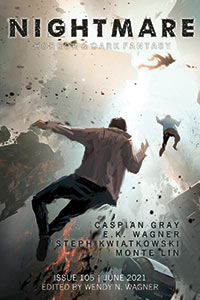 Nightmare, <www.nightmare-magazine.com>, edited by Wendy N. Wagner, published 12 monthly issues, online and electronic, with 43 horror and dark fantasy stories (27 originals shorts, 11 original flash, and five reprints) plus poetry and non-fiction. Wagner said she’d like to see ‘‘more story fiction submissions that run under 4,000 words, and more flash stories that run less than 1,000 words. I think there was a lot of response for very touching stories (E.A. Petricone’s story ‘We the Girls Who Did Not Make It’ and Julianna Baggott’s story ‘Inkmorphia’ are good examples) and also for our stranger stories, like Gordon B. White’s ‘Gordon B. White is creating Haunting Weird Horror.’’’ Issues were free online, $3.99 for electronic, and $2.99 for subscribers. Pay was $.08/word. Average monthly uniques were 13,651 and 1,477 ebook subscribers. [Professional]
Nightmare, <www.nightmare-magazine.com>, edited by Wendy N. Wagner, published 12 monthly issues, online and electronic, with 43 horror and dark fantasy stories (27 originals shorts, 11 original flash, and five reprints) plus poetry and non-fiction. Wagner said she’d like to see ‘‘more story fiction submissions that run under 4,000 words, and more flash stories that run less than 1,000 words. I think there was a lot of response for very touching stories (E.A. Petricone’s story ‘We the Girls Who Did Not Make It’ and Julianna Baggott’s story ‘Inkmorphia’ are good examples) and also for our stranger stories, like Gordon B. White’s ‘Gordon B. White is creating Haunting Weird Horror.’’’ Issues were free online, $3.99 for electronic, and $2.99 for subscribers. Pay was $.08/word. Average monthly uniques were 13,651 and 1,477 ebook subscribers. [Professional]
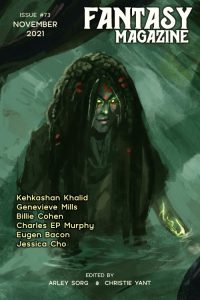 Fantasy, <www.fantasy-magazine.com>, co-edited by Christie Yant & Arley Sorg, published 12 monthly issues, online and electronic, with two original short stories, two flash pieces, and two poems in each issue, plus non-fiction. Co-editors Yant & Sorg were nominated for a World Fantasy Award. ‘‘Writers should write what is important to them: Tell the stories you need to tell, and do it well. Reviewers and readers have varying tastes, and most, if not all, our stories were well-received by some group. We loved all the stuff we published, and it’s incredibly difficult to talk about ‘top stories’ – but a few ‘standout’ stories, for us, include C.E. McGill’s ‘Things to Bring, Things to Burn, Things Best Left Behind’ and Innocent Chizaram Ilo’s ‘Flight’.’’ Issues were free online, $3.99 for electronic, and $2.99 for subscribers. Pay was $.08/word. [Professional]
Fantasy, <www.fantasy-magazine.com>, co-edited by Christie Yant & Arley Sorg, published 12 monthly issues, online and electronic, with two original short stories, two flash pieces, and two poems in each issue, plus non-fiction. Co-editors Yant & Sorg were nominated for a World Fantasy Award. ‘‘Writers should write what is important to them: Tell the stories you need to tell, and do it well. Reviewers and readers have varying tastes, and most, if not all, our stories were well-received by some group. We loved all the stuff we published, and it’s incredibly difficult to talk about ‘top stories’ – but a few ‘standout’ stories, for us, include C.E. McGill’s ‘Things to Bring, Things to Burn, Things Best Left Behind’ and Innocent Chizaram Ilo’s ‘Flight’.’’ Issues were free online, $3.99 for electronic, and $2.99 for subscribers. Pay was $.08/word. [Professional]
 Clarkesworld, <clarkesworldmagazine.com>, published 12 online, electronic, and print issues, with 83 pieces of original fiction – all with podcast editions – and assorted non-fiction. Covers were high quality, original art. Publisher was Neil Clarke. Clarke said, ‘‘It was challenging for most of the reasons you’d expect and then add some health issues that made it even more complicated for me. It wasn’t uncommon to have to employ a plan B, C, or D to remain on schedule or to defer other plans, such as our Spanish language submissions window, which is now scheduled for 2022. Our continued efforts to improve pay for everyone involved with the magazine completed its first full cycle ending with the increase in author pay to 12 cents/word. Far from done, this will continue to be a priority in 2022. Over half the authors we published in 2021 had never appeared in Clarkesworld before.’’ The website had 44,000 unique visitors per month, and there were around 4,000 digital subscribers, up from 3,850 last year, 300 print subscribers, with 200-300 digital single-issue and 50 print bookstore sales monthly. Print cover price remained $7.99; electronic issues were $3.99 with subscription. Clarkesworld pays $.12/word, up from $.10. [Professional]
Clarkesworld, <clarkesworldmagazine.com>, published 12 online, electronic, and print issues, with 83 pieces of original fiction – all with podcast editions – and assorted non-fiction. Covers were high quality, original art. Publisher was Neil Clarke. Clarke said, ‘‘It was challenging for most of the reasons you’d expect and then add some health issues that made it even more complicated for me. It wasn’t uncommon to have to employ a plan B, C, or D to remain on schedule or to defer other plans, such as our Spanish language submissions window, which is now scheduled for 2022. Our continued efforts to improve pay for everyone involved with the magazine completed its first full cycle ending with the increase in author pay to 12 cents/word. Far from done, this will continue to be a priority in 2022. Over half the authors we published in 2021 had never appeared in Clarkesworld before.’’ The website had 44,000 unique visitors per month, and there were around 4,000 digital subscribers, up from 3,850 last year, 300 print subscribers, with 200-300 digital single-issue and 50 print bookstore sales monthly. Print cover price remained $7.99; electronic issues were $3.99 with subscription. Clarkesworld pays $.12/word, up from $.10. [Professional]
There were 12 issues of Forever, <forever-magazine.com>, Clarke’s ‘‘reprint only’’ project, each featuring a novella and two short stories. The magazine was available in digital formats for $2.99 per issue or by subscription. [Professional]
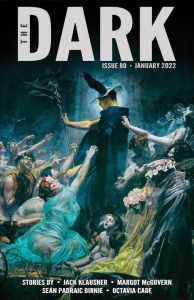 The Dark Magazine, <www.thedarkmagazine.com>, published 48 original ‘‘dark and strange’’ stories in 12 issues, online and electronic, edited by Sean Wallace. Wallace said, ‘‘Some of the more popular stories included ‘Laughter Among the Trees’ by Suzan Palumbo, along with ‘The Van Etten House’ by Carrie Laben and ‘Eating Bitterness’ by Hannah Yang.’’ Issues were free online, $2.99 for ebook, $1.99 for subscribers. There were about 5,000 uniques monthly, with 1,138 paid subscribers. Pay was $.06/word. [Professional]
The Dark Magazine, <www.thedarkmagazine.com>, published 48 original ‘‘dark and strange’’ stories in 12 issues, online and electronic, edited by Sean Wallace. Wallace said, ‘‘Some of the more popular stories included ‘Laughter Among the Trees’ by Suzan Palumbo, along with ‘The Van Etten House’ by Carrie Laben and ‘Eating Bitterness’ by Hannah Yang.’’ Issues were free online, $2.99 for ebook, $1.99 for subscribers. There were about 5,000 uniques monthly, with 1,138 paid subscribers. Pay was $.06/word. [Professional]
 Galaxy’s Edge, <www.galaxysedge.com>, edited by Lezli Robyn and published by Shahid Mahmud, produced six print issues between 104-120 pages, 19 x 24.5 cm, perfect bound, with b&w interiors on book print and color matte covers from astronauts to mermaids, with 54 works of short fiction, including 33 originals, 19 standard reprints, and 2 reprint serials, plus 13 pieces of non-fiction. There were 7,500 average unique monthly website visitors, slightly down from last year, and 600 subscriptions (digital and paper, including trial subs). Fiction was free online, print cover price was $7.99, ebook $4.99. Pay rate was $.07/word for new fiction. [Professional]
Galaxy’s Edge, <www.galaxysedge.com>, edited by Lezli Robyn and published by Shahid Mahmud, produced six print issues between 104-120 pages, 19 x 24.5 cm, perfect bound, with b&w interiors on book print and color matte covers from astronauts to mermaids, with 54 works of short fiction, including 33 originals, 19 standard reprints, and 2 reprint serials, plus 13 pieces of non-fiction. There were 7,500 average unique monthly website visitors, slightly down from last year, and 600 subscriptions (digital and paper, including trial subs). Fiction was free online, print cover price was $7.99, ebook $4.99. Pay rate was $.07/word for new fiction. [Professional]
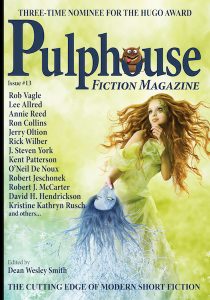 We saw six perfect-bound, 17.5 x 25.5 cm issues of Pulphouse, <pulphousemagazine.com>, 152-220 pages, with glossy color covers and b&w interiors, hosting 115 short stories, of which 31 were reprints. Editor was Dean Wesley Smith, with executive editor Kristine Kathryn Rusch. Publisher Allyson Longueira of WMG Publishing said, ‘‘After the challenges of 2020, 2021 was a growth year for us for the most part. Although we decided in 2020 to shift our focus from Fiction River to our Pulphouse and Smith’s Monthly lines. As such, in 2021, we relaunched Smith’s Monthly, with 12 issues as the name implies, and increased our Pulphouse release schedule from four issues per year to six.’’ Cover price was $9.99 for issues #10 and #12 and $12.99 for the rest, $6.99 for ebook, up from $5.99. Pay rate was $.06/word for original fiction, $100 flat fee for first-run reprints. [Professional]
We saw six perfect-bound, 17.5 x 25.5 cm issues of Pulphouse, <pulphousemagazine.com>, 152-220 pages, with glossy color covers and b&w interiors, hosting 115 short stories, of which 31 were reprints. Editor was Dean Wesley Smith, with executive editor Kristine Kathryn Rusch. Publisher Allyson Longueira of WMG Publishing said, ‘‘After the challenges of 2020, 2021 was a growth year for us for the most part. Although we decided in 2020 to shift our focus from Fiction River to our Pulphouse and Smith’s Monthly lines. As such, in 2021, we relaunched Smith’s Monthly, with 12 issues as the name implies, and increased our Pulphouse release schedule from four issues per year to six.’’ Cover price was $9.99 for issues #10 and #12 and $12.99 for the rest, $6.99 for ebook, up from $5.99. Pay rate was $.06/word for original fiction, $100 flat fee for first-run reprints. [Professional]
 Fiction River, <www.fictionriver.com>, an ‘‘original anthology magazine,’’ produced two tall, digest-size regular print issues at 230-282 pages, perfect bound with glossy color covers and b&w interiors, with 20 pieces of fiction, all original. Themes were ‘‘Dark & Deadly Passions’’ and ‘‘Chances’’; series editors were Kristine Kathryn Rusch & Dean Wesley Smith. Publisher was Allyson Longueira. Cover price was $15.99, $6.99 for ebook, less for subscribers. Pay rate was $.06/word. [Professional]
Fiction River, <www.fictionriver.com>, an ‘‘original anthology magazine,’’ produced two tall, digest-size regular print issues at 230-282 pages, perfect bound with glossy color covers and b&w interiors, with 20 pieces of fiction, all original. Themes were ‘‘Dark & Deadly Passions’’ and ‘‘Chances’’; series editors were Kristine Kathryn Rusch & Dean Wesley Smith. Publisher was Allyson Longueira. Cover price was $15.99, $6.99 for ebook, less for subscribers. Pay rate was $.06/word. [Professional]
SEMIPROZINE
These are our semiprozine fiction venues, loosely organized by pay rate and quantity of stories printed. SFWA qualifying status is now $.08/word, so about the first half of the semiprozines qualify.
Fireside was available as a monthly ebook for subscribers, with that month’s stories published free online after at <firesidefiction.com>, with 49 short stories, all but one original, and two poems. L.D. Lewis was publisher and Chelle Parker was managing editor. Brian J. White was executive editor and owner; guest editors were Ryan Boyd, Yanni Kuznia, and Danny Lore. Unique visitors averaged around 10,000 per month, same as last year, with about 15,000 hits/month and 500 ebook subscribers. Pay rate was 12.5 cents per word. [Semiprozine]
 Uncanny, <uncannymagazine.com>, published six issues, online and electronic, with 38 original stories – including one novella and seven novelettes – and four reprints, as well as essays, poems, interviews, and podcasts. Lynne M. Thomas & Michael Damian Thomas were co-editors-in-chief. Going into 2022, Meg Elison is taking over as non-fiction editor, Naomi Day will be the new senior assistant editor, and Monte Lin is taking over as assistant editor. The mag was a 2021 Hugo Award finalist for Best Semiprozine. ‘‘The Inaccessibility of Heaven’’ by Aliette de Bodard won the 2021 Best Novelette Ignyte Award, and ‘‘You Perfect, Broken Thing’’ by C.L. Clark won the 2021 Best Short Story Ignyte Award. ‘‘Metal Like Blood in the Dark’’ by T. Kingfisher was the 2021 WSFA Small Press Award Winner. Uncanny stories were finalists for Hugo, Nebula, Locus, Eugie, Sturgeon, Ignyte, and World Fantasy Awards, and editors-in-chief Lynne M. Thomas & Michael Damian Thomas were finalists for World Fantasy and Locus Awards. They also successfully funded their eighth Kickstarter. ‘‘The stories with the best responses were ones with gorgeous prose and wonderful characters that elicited strong emotions from the readers. We always want to see more own-voices stories.’’ Issues were free online, $3.99 for electronic, and $1.99 for subscribers. Uncanny had 2,600 subscribers and averaged 48,000 uniques. Pay was $.10/word for fiction. [Semiprozine]
Uncanny, <uncannymagazine.com>, published six issues, online and electronic, with 38 original stories – including one novella and seven novelettes – and four reprints, as well as essays, poems, interviews, and podcasts. Lynne M. Thomas & Michael Damian Thomas were co-editors-in-chief. Going into 2022, Meg Elison is taking over as non-fiction editor, Naomi Day will be the new senior assistant editor, and Monte Lin is taking over as assistant editor. The mag was a 2021 Hugo Award finalist for Best Semiprozine. ‘‘The Inaccessibility of Heaven’’ by Aliette de Bodard won the 2021 Best Novelette Ignyte Award, and ‘‘You Perfect, Broken Thing’’ by C.L. Clark won the 2021 Best Short Story Ignyte Award. ‘‘Metal Like Blood in the Dark’’ by T. Kingfisher was the 2021 WSFA Small Press Award Winner. Uncanny stories were finalists for Hugo, Nebula, Locus, Eugie, Sturgeon, Ignyte, and World Fantasy Awards, and editors-in-chief Lynne M. Thomas & Michael Damian Thomas were finalists for World Fantasy and Locus Awards. They also successfully funded their eighth Kickstarter. ‘‘The stories with the best responses were ones with gorgeous prose and wonderful characters that elicited strong emotions from the readers. We always want to see more own-voices stories.’’ Issues were free online, $3.99 for electronic, and $1.99 for subscribers. Uncanny had 2,600 subscribers and averaged 48,000 uniques. Pay was $.10/word for fiction. [Semiprozine]
Strange Horizons, <www.strangehorizons.com>, published 50 weekly online issues with 47 original stories, two novelettes, one translated story (published in both Arabic and English), plus poetry, reviews, and articles. Editor-in-chief Vanessa Rose Phin left in June, along with several other staff members, and Gautam Bhatia became coordinating editor. ‘‘We are particularly proud of our special issues – our Palestine special, our trans special, and our friendship special. In 2022, we’re looking to have special issues on reviews and criticism in SFF, visual art in SFF, music, and extractivism.’’ Their annual Kickstarter saw 283 individual backers for $17,515. Pay rate was $.10/word for fiction. [Semiprozine]
Strange Horizons’s sister magazine Samovar, ‘‘a quarterly magazine of and about translated speculative fiction,’’ edited by Sarah Dodd, Laura Friis & Greg West, produced three online issues with 12 stories and their accompanying translations. Pay rate was $.08/word up to $300.
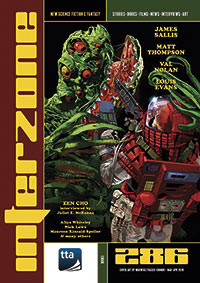 Interzone and Black Static, <www.ttapress.com>, from TTA Press are two well-known genre UK print and electronic publications edited by veteran Andy Cox. It was an unusual year for Interzone – the prospect of handing off ownership of the magazine was explored but ultimately fell through. Interzone had one print double issue, 17 x 24 cm, perfect bound, with 192 pages and a glossy color cover of a futuristic motorbike rider; interiors were color on uncoated stock. There were six short stories and three novelettes for nine pieces of fiction, down from 24, plus book and film reviews and other non-fiction. Cover price was £11.99/print, £7.00/ebook. [Semiprozine]
Interzone and Black Static, <www.ttapress.com>, from TTA Press are two well-known genre UK print and electronic publications edited by veteran Andy Cox. It was an unusual year for Interzone – the prospect of handing off ownership of the magazine was explored but ultimately fell through. Interzone had one print double issue, 17 x 24 cm, perfect bound, with 192 pages and a glossy color cover of a futuristic motorbike rider; interiors were color on uncoated stock. There were six short stories and three novelettes for nine pieces of fiction, down from 24, plus book and film reviews and other non-fiction. Cover price was £11.99/print, £7.00/ebook. [Semiprozine]
There were two print double issues of Black Static, 15.5 x 23 cm, perfect bound, with 190-194 pages, a glossy color cover, and b&w interiors, with 18 pieces of fiction, down from 27 last year, plus reviews and other non-fiction. Covers were a ghostly figure in an attic and a skeletal violinist. These issues were the first Black Static double issues and TTA Press is no longer accepting new subscriptions, instead requesting individual issue preorders to support the magazine. Cover price was £11.99/print, £7.00/ebook. TTA remains one of the few fiction markets that does not disclose pay rates. [Semiprozine]
Diabolical Plots, <www.diabolicalplots.com>, edited by David Steffen, published 24 stories in 12 monthly online issues, and plans to publish reprints in The Long List Anthology Volume 7. Steffen said, ‘‘In the past we had typically had between 5 and 10 first readers (slushreaders) but we expanded the team to almost 30. In addition, Kel Coleman joined the team as an assistant editor alongside Ziv Wities who joined last year. 2021 has been a momentous year for Diabolical Plots in terms of awards, with ‘Open House On Haunted Hill’ winning the Nebula Award for Best Short Story, a finalist for the Hugo Award, as well as nominations for World Fantasy Award, Small Press Award, and Stabby award. Those are John Wiswell’s first major award nominations/wins, and these are the first time that stories published in Diabolical Plots have been nominated for or won major awards as well.’’ Pay was $.10/word, $.01/word for reprint fiction + royalty share for the anthology. Uniques/month averaged about 18,000, with about 900 newsletter subscribers. [Semiprozine]
Lady Churchill’s Rosebud Wristlet, <smallbeerpress.com/lcrw>, produced two saddle-stitched, oversize chapbooks, with b&w covers and interiors, 60-64 pages, with 16 pieces of short fiction including one reprint, nine poems, and some non-fiction. Print subscriptions increased to 320 from 280; ebook subscriptions were down to 67 from 80. Co-editors were Gavin J. Grant & Kelly Link. Grant said, ‘‘It was a good year, many of the stories seemed well received although Alisa Alering’s ‘The Night Farmers’ Museum’ stood out for some readers.’’ Cover price was $6.00, up from $5.00, $3.00/ebook, up from $2.99. Pay rate was $.03/word, $25 minimum, and $10/poem. [Semiprozine]
 Beneath Ceaseless Skies, <www.beneath-ceaseless-skies.com>, a biweekly ‘‘literary adventure fantasy’’ magazine published and edited by Scott H. Andrews, produced 26 online issues containing 33 short stories, 19 novelettes, and two novellas for a total 54 pieces of original fiction and 22 podcast episodes, including their 13th-anniversary double-issue. Andrews said, ‘‘Accolades included a ninth Hugo Award finalist for Best Semiprozine, an eleventh World Fantasy Award finalist, a second Ignyte Award finalist for Best Podcast, and ‘The Mermaid Astronaut’ by Yoon Ha Lee a Hugo Award finalist for Best Short Story.’’ The website averaged 70,000 uniques per month; podcasts averaged 9,000 downloads per episode. Pay rate was $.08/word. [Semiprozine]
Beneath Ceaseless Skies, <www.beneath-ceaseless-skies.com>, a biweekly ‘‘literary adventure fantasy’’ magazine published and edited by Scott H. Andrews, produced 26 online issues containing 33 short stories, 19 novelettes, and two novellas for a total 54 pieces of original fiction and 22 podcast episodes, including their 13th-anniversary double-issue. Andrews said, ‘‘Accolades included a ninth Hugo Award finalist for Best Semiprozine, an eleventh World Fantasy Award finalist, a second Ignyte Award finalist for Best Podcast, and ‘The Mermaid Astronaut’ by Yoon Ha Lee a Hugo Award finalist for Best Short Story.’’ The website averaged 70,000 uniques per month; podcasts averaged 9,000 downloads per episode. Pay rate was $.08/word. [Semiprozine]
Daily Science Fiction, <dailysciencefiction.com>, co-published and co-edited by Michele-Lee Barasso & Jonathan Laden, published 260 stories online and by email delivery. Pay was $.08/word up to 1,500 words. [Semiprozine]
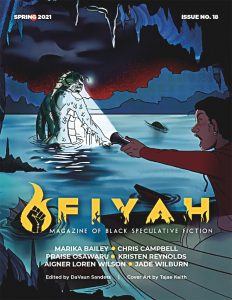 Fiyah, <www.fiyahlitmag.com>, the ‘‘Magazine of Black Speculative Fiction,’’ published 24 original stories plus poems in four scheduled electronic issues and one Palestinian Solidarity special issue, as well as hosting the second FIYAHCON and Ignyte Awards. Fiyah won the 2021 Best Semiprozine Hugo Award. Executive editor DaVaun Sanders said, ‘‘Submissions for our themed issues this year were wonderful, and made for some tough decisions. We’ll continue with our even split between themed and unthemed issues for 2022, with the two themed issues dealing with ‘Hauntings and Horrors’ and ‘Food and Cuisine.’’’ Pay was $.08/word for fiction, with 2,122 subscribers and 4,800 unique visitors per month. [Semiprozine]
Fiyah, <www.fiyahlitmag.com>, the ‘‘Magazine of Black Speculative Fiction,’’ published 24 original stories plus poems in four scheduled electronic issues and one Palestinian Solidarity special issue, as well as hosting the second FIYAHCON and Ignyte Awards. Fiyah won the 2021 Best Semiprozine Hugo Award. Executive editor DaVaun Sanders said, ‘‘Submissions for our themed issues this year were wonderful, and made for some tough decisions. We’ll continue with our even split between themed and unthemed issues for 2022, with the two themed issues dealing with ‘Hauntings and Horrors’ and ‘Food and Cuisine.’’’ Pay was $.08/word for fiction, with 2,122 subscribers and 4,800 unique visitors per month. [Semiprozine]
Abyss & Apex Magazine, <www.abyssapexzine.com>, published 25 original stories, plus book reviews, editorials, and poems in four quarterly issues. Editor and publisher Wendy S. Delmater said, ‘‘There was a marked tendency for our fantasies to be more popular, which we measure by which tales get the most unique viewers, and if they seem to have ‘legs’ and remain popular for several months… which we believe is due to the digital equivalent of word-of-mouth recommendations. ‘Tanya Got a Dragon’ is amazing… we pushed that to New Year’s Day, 2022 this year because we want it to have all year to pick up readers.’’ Average unique visitors per month was 12,903. Pay was $.08/word to 1,000 words, with a max of $80. [Semiprozine]
New magazine Mermaid’s Monthly <mermaidsmonthly.com>, co-published and founded by Julia Rios and Meg Frank, produced 12 mermaid-themed digital issues with 71 short stories, 54 poems, and assorted comics and non-fiction, available free online and electronically. Next year’s editors will be Miyuki Jane Pinckard, Noelle Singh & Vida Cruz. Pay was $.10/word [Semiprozine]
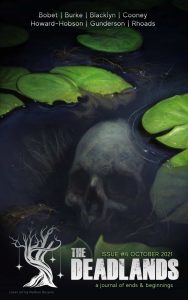 New online literary spec-fic magazine, The Deadlands, <thedeadlands.com>, ‘‘an adventure into the unknown, to meet those who live there still, even though they may be dead,’’ published 15 original stories, four reprints, 32 original poems, and non-fiction in eight online issues. Former Shimmer editor E. Catherine Tobler is editor-in-chief. Tobler said, ‘‘2021 was our first year, so there’s absolutely a learning curve, especially given it was also our first Kickstarter…. [W]e’d definitely love to see more international stories that explore death and traditions/myths we may not be familiar with.’’ They averaged 3,400 unique visitors per month with 458 subscribers. Pay was $.10/word for fiction, $50/poem, $100/non-fiction. [Semiprozine]
New online literary spec-fic magazine, The Deadlands, <thedeadlands.com>, ‘‘an adventure into the unknown, to meet those who live there still, even though they may be dead,’’ published 15 original stories, four reprints, 32 original poems, and non-fiction in eight online issues. Former Shimmer editor E. Catherine Tobler is editor-in-chief. Tobler said, ‘‘2021 was our first year, so there’s absolutely a learning curve, especially given it was also our first Kickstarter…. [W]e’d definitely love to see more international stories that explore death and traditions/myths we may not be familiar with.’’ They averaged 3,400 unique visitors per month with 458 subscribers. Pay was $.10/word for fiction, $50/poem, $100/non-fiction. [Semiprozine]
Augur, <www.augurmag.com>, an online literary spec-fic magazine, published 18 stories, plus poetry, comics, and art in two issues. Lawrence Stewen & Terese Mason Pierre were co-editors-in-chief. Pay was C$0.11/word for short fiction, C$110 flat for flash fiction up to 1,000 words, C$60 for poetry, C$50 per page up to C$200.00 for graphic fiction. [Semiprozine]
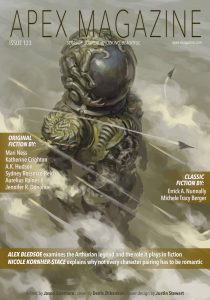 Apex, <www.apex-magazine.com>, produced eight digital issues with 48 original stories and 16 reprints, and assorted non-fiction. Editor-in-chief Jason Sizemore said, ‘‘We had a fantastic 2021. After being on hiatus for nearly two years, we relaunched in January and out of the gate had several defining stories appear (‘‘Mr. Death’’ by Alix E. Harrow, ‘‘Root Rot’’ by Fargo Tbakhi). Our two bonus issues were well-received (Indigenous Futurists, International Futurists) and our podcast doubled its audience…. Due to the hiatus, we lost our entire subscriber base, so it’s been a climb back to form. We’d like to see more stories from Indigenous authors (from all regions of the world).’’ There were 20,000 unique visitors with 60,000 hits/month and 800 subscribers; free online and in ebook for $4.99. Pay rate was $.08/word for original fiction, up from $.06. [Professional]
Apex, <www.apex-magazine.com>, produced eight digital issues with 48 original stories and 16 reprints, and assorted non-fiction. Editor-in-chief Jason Sizemore said, ‘‘We had a fantastic 2021. After being on hiatus for nearly two years, we relaunched in January and out of the gate had several defining stories appear (‘‘Mr. Death’’ by Alix E. Harrow, ‘‘Root Rot’’ by Fargo Tbakhi). Our two bonus issues were well-received (Indigenous Futurists, International Futurists) and our podcast doubled its audience…. Due to the hiatus, we lost our entire subscriber base, so it’s been a climb back to form. We’d like to see more stories from Indigenous authors (from all regions of the world).’’ There were 20,000 unique visitors with 60,000 hits/month and 800 subscribers; free online and in ebook for $4.99. Pay rate was $.08/word for original fiction, up from $.06. [Professional]
Mysterion, <www.mysteriononline.com>, edited and published by Donald S. Crankshaw & Kristin Janz, published 14 original stories in blog format. ‘‘We were thrilled to see one of the stories we published in 2020, Caias Ward’s ‘Reformed’, as a finalist for this year’s Washington Science Fiction Association Small Press Award. We would love to see more far-future hard SF, more stories featuring devout Christians who are not priests or ministers, and more stories from authors in Latin America, Asia, and Africa.’’ Pay was $.08/word for originals, $.04/word for reprints, with about 480 average unique visitors per month and 1,400 hits per month. [Semiprozine]
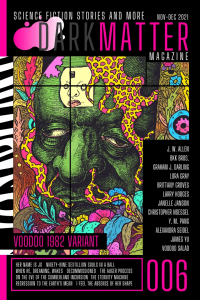 There were six regular and one special Halloween issue of new magazine Dark Matter, <darkmattermagazine.com>, offering a blend of science fiction and horror in 72 stories including seven reprints, five poems, four comics, and assorted non-fiction, available in print, electronically, and in audiobook. Print issues were 15 x 23 cm with matte color covers and color interiors on uncoated stock, 124-172 pages. Editor-in-chief Rob Carroll said, ‘‘2021 was an absolute blast, and the response that Dark Matter Magazine received this past year has exceeded my wildest expectations. I would love to see more near-future science fiction that tackles the problems of today.’’ $15.00/print, $4.99/ebook. Pay was $0.08/word for original fiction, $0.02 reprint. [Semiprozine]
There were six regular and one special Halloween issue of new magazine Dark Matter, <darkmattermagazine.com>, offering a blend of science fiction and horror in 72 stories including seven reprints, five poems, four comics, and assorted non-fiction, available in print, electronically, and in audiobook. Print issues were 15 x 23 cm with matte color covers and color interiors on uncoated stock, 124-172 pages. Editor-in-chief Rob Carroll said, ‘‘2021 was an absolute blast, and the response that Dark Matter Magazine received this past year has exceeded my wildest expectations. I would love to see more near-future science fiction that tackles the problems of today.’’ $15.00/print, $4.99/ebook. Pay was $0.08/word for original fiction, $0.02 reprint. [Semiprozine]
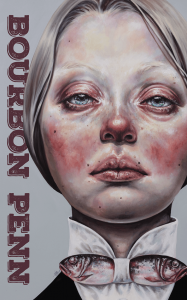 Bourbon Penn produced three perfect-bound issues, 12.75 x 20 cm, 135-150 pages, with color, glossy covers and b&w interiors, with 18 original short stories, also available in ebook and for free at <www.bourbonpenn.com>. Covers were excellent quality, ranging from a collection of surreal insects with human features to a hallucinogenic cartoon animal. Editor Erik Secker said, ‘‘We added a number of new supporters via Patreon in 2021 and are optimistic that we’ll be able to increase our pay rate to 3¢/word in 2022.’’ Print cover price was $12.95; ebook $2.99. Pay rate was $.02/word. [Semiprozine]
Bourbon Penn produced three perfect-bound issues, 12.75 x 20 cm, 135-150 pages, with color, glossy covers and b&w interiors, with 18 original short stories, also available in ebook and for free at <www.bourbonpenn.com>. Covers were excellent quality, ranging from a collection of surreal insects with human features to a hallucinogenic cartoon animal. Editor Erik Secker said, ‘‘We added a number of new supporters via Patreon in 2021 and are optimistic that we’ll be able to increase our pay rate to 3¢/word in 2022.’’ Print cover price was $12.95; ebook $2.99. Pay rate was $.02/word. [Semiprozine]
There were two print issues of DreamForge Magazine, <dreamforgemagazine.com>, also available electronically as six bi-monthly issues of DreamForge Anvil, <dreamforgemagazine.com/anvil/>, with 32 stories, 30 originals and two reprints. Most stories were also made available free online through a reader portal. Publisher and editor Scot Noel said, ‘‘Hopepunk, solarpunk, and stories with an optimistic, empathetic viewpoint [got the best response]…. Our focus is turning toward building a community around the magazine through our Patreon supported DreamCasters discussion and writing group and toward establishing a DreamForge YouTube Channel, another community building venue.’’ Print issue price was $14.99 through Amazon, digital subscription was $17.99/six issues plus access to all back issues, or Kindle at $2.99/issue. Pay rate was $.06/word for new fiction, $.03/word reprint. [Semiprozine]
Frozen Wavelets, <frozenwavelets.com>, ‘‘offspring of The Earthian Hivemind,’’ a dark fiction periodical edited by Steph P. Bianchini, published 13 original stories, two reprints, and poetry in two issues. ‘‘We never receive enough (good) science-fiction or fiction in translation. We’d love to publish more of the second, especially for poetry.’’ Pay was $.08/word for fiction, $1/line for poetry.
khōréō, <www.khoreomag.com>, helmed by founder/editor-in-chief Aleksandra Hill and editor Rowan Morrison, is ‘‘a quarterly magazine of speculative fiction and migration.’’ They published 18 original stories, three reprints, plus non-fiction in four issues. ‘‘Two that have had some of the most traffic on our website are ‘The Frankly Impossible Weight of Han’ by Maria Dong, a genre-bending science fantasy, and ‘All Worlds Left Behind’ by Iona Datt Sharma, a portal fantasy. We’ve published everything from near-future cli-fi to epistolary magical realism.’’ They had 400 subscribers and an average 1,700 unique visitors per month. Pay was $.08/word. [Semiprozine]
We saw three issues of On Spec, <www.onspecmag.wordpress.com>, a Canadian print digest, 114-137 pages, perfect bound, with 24 stories, all but one original, six poems, and assorted non-fiction. Semi-gloss covers ranged from a blue-green dragon to a cartoon of a man and cat on a bicycle. Diane L. Walton was managing editor and The Copper Pig Writers’ Society was publisher. Walton said, ‘‘What we look forward to seeing more of is good, ‘hard’ science fiction stories.’’ Average print run was 500, up from 400 last year, with a subscriber base of 380. The magazine was available in PDF, mobi, and epub from Weightless. Regular issue price was C$6.95, less for subscribers. Pay rate was C$.05. [Semiprozine]
Cosmic Roots and Eldritch Shores, <cosmicrootsandeldritchshores.com>, edited by Fran Eisemann published six original stories, one reprint, and one poem. ‘‘For us, for 2022, we hope to put out more stories and articles. But as part of the media we’re also thinking about how we’ll be affected, and how can we make a positive contribution in a world with worsening political and climate changes. These things are not our areas, but silence is not the answer?’’ There were 3,200 uniques/month, about 250 subscribers, and pay was $.08/word for new fiction, $.02/word for reprints. [Semiprozine]
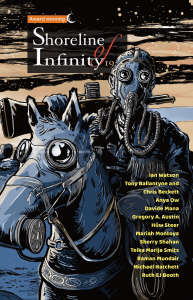 Shoreline of Infinity, <www.shorelineofinfinity.com>, based out of Scotland, published 39 stories and 20 poems in eight PDF issues, and 19 stories, 7 poems (many reprints from the digital issues) in two print plus PDF editions (#23 and #29), 152-154 pages, perfect bound, digest-sized with b&w interiors and glossy color covers. Editor-in-chief Noel Chidwick said, ‘‘Despite Long-Covid bringing down the Editor-in-Chief for a good part of the year, we published nine monthly digital issues, two print issues, a special print issue, and two ‘Story on a Mug’ – the Mugazine, if you will. Our first two mugs feature stories by Ken MacLeod and Ian Watson. 2021 was an experimental year for Shoreline. We wanted to explore variations on how to reach a wider audience. We moved to publish a monthly ebook/PDF edition from March, releasing this issue under pay-what-you-can…. Issue 20 (March) featured women only writers, September shone a spotlight on science fiction by trans, nonbinary and gender-nonconforming writers and November showcased stories by Disabled and neurodivergent writers.’’ Print run was 150, with 80 subscribers and 90 digital sales/issue. Print prices ranged from £7.45-£8.45, digital/£2.70 with some issues being free/pay what you can, with 4,500 unique website visitors monthly. Pay rate was $.06/word, maximum 5,000 words, well up from last year’s £10/1,000 words. [Semiprozine]
Shoreline of Infinity, <www.shorelineofinfinity.com>, based out of Scotland, published 39 stories and 20 poems in eight PDF issues, and 19 stories, 7 poems (many reprints from the digital issues) in two print plus PDF editions (#23 and #29), 152-154 pages, perfect bound, digest-sized with b&w interiors and glossy color covers. Editor-in-chief Noel Chidwick said, ‘‘Despite Long-Covid bringing down the Editor-in-Chief for a good part of the year, we published nine monthly digital issues, two print issues, a special print issue, and two ‘Story on a Mug’ – the Mugazine, if you will. Our first two mugs feature stories by Ken MacLeod and Ian Watson. 2021 was an experimental year for Shoreline. We wanted to explore variations on how to reach a wider audience. We moved to publish a monthly ebook/PDF edition from March, releasing this issue under pay-what-you-can…. Issue 20 (March) featured women only writers, September shone a spotlight on science fiction by trans, nonbinary and gender-nonconforming writers and November showcased stories by Disabled and neurodivergent writers.’’ Print run was 150, with 80 subscribers and 90 digital sales/issue. Print prices ranged from £7.45-£8.45, digital/£2.70 with some issues being free/pay what you can, with 4,500 unique website visitors monthly. Pay rate was $.06/word, maximum 5,000 words, well up from last year’s £10/1,000 words. [Semiprozine]
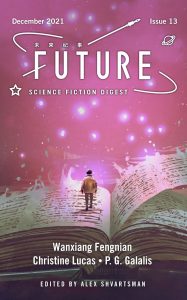 Future Science Fiction Digest, <future-sf.com>, published four issues with 18 original stories, including one novella, ‘‘with a strong focus on translation and international fiction.’’ Editor Alex Shvartsman said, ‘‘People love translations, but perhaps our most popular story this year was an original piece by Jane Espenson. We’d love to see more translations from Africa and Central Asia.’’ Pay was $.08/word. There were roughly 3,600 readers per month. Fiction is free online, $2.99/ebook. [Semiprozine]
Future Science Fiction Digest, <future-sf.com>, published four issues with 18 original stories, including one novella, ‘‘with a strong focus on translation and international fiction.’’ Editor Alex Shvartsman said, ‘‘People love translations, but perhaps our most popular story this year was an original piece by Jane Espenson. We’d love to see more translations from Africa and Central Asia.’’ Pay was $.08/word. There were roughly 3,600 readers per month. Fiction is free online, $2.99/ebook. [Semiprozine]
Grimdark, <grimdarkmagazine.com>, published 18 stories in four issues focusing on ‘‘the grittier nature of people in futuristic or fantasy settings.’’ Founder Adrian Collins was editor-in-chief. ‘‘On the plus side, we ran a successful Kickstarter for The King Must Fall dark fantasy anthology alongside publication of four issues.’’ Collins reported around 45,000 hits/month and 150+ subscriptions via Patreon. Pay was A$.07/word. [Semiprozine]
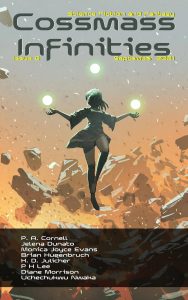 We saw three issues of Cossmass Infinities, <www.cossmass.com>, digest size with matte color covers and b&w interiors, with 25 original stories. Editor Paul Campbell said, ‘‘Emotional and somewhat painful stories [got the best response]. Not expansively expressed, but deeply felt. I’d like more of the same, keeping that emotion tied to the genre elements, and staying clear of melodrama.’’ Average unique visitors per month were 825, with 3,426 hits per month. There were 50 ebook subscribers, including 21 Patreon supporters, and 67 print copies sold through Amazon POD. Cover price was $9.00/print, $3.99/ebook. Pay rate was $.08/word. [Semiprozine]
We saw three issues of Cossmass Infinities, <www.cossmass.com>, digest size with matte color covers and b&w interiors, with 25 original stories. Editor Paul Campbell said, ‘‘Emotional and somewhat painful stories [got the best response]. Not expansively expressed, but deeply felt. I’d like more of the same, keeping that emotion tied to the genre elements, and staying clear of melodrama.’’ Average unique visitors per month were 825, with 3,426 hits per month. There were 50 ebook subscribers, including 21 Patreon supporters, and 67 print copies sold through Amazon POD. Cover price was $9.00/print, $3.99/ebook. Pay rate was $.08/word. [Semiprozine]
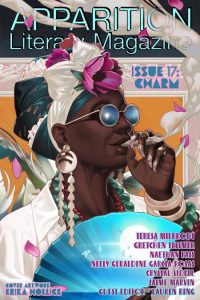 Apparition Lit, <apparitionlit.com>, ‘‘strange, misshapen stories with enough emotional heft to break a heart, with prose that’s as clear and delicious as broth,’’ is an online and digital literary spec-fic magazine by owners/senior editors Rebecca Bennett, Clarke Doty, Amy Henry Robinson & Tacoma Tomilson. They published 29 original stories in four issues. ‘‘Two of our best reviewed stories were: ‘Bride, Knife, Flaming Horse’ by M.L. Krishnan and ‘I Wear Spiders in Remembrance of Myself’ by Kel Coleman.’’ They had 89 subscribers and an average 7,489 uniques per month. Pay was $.03/word for fiction, $30/poem. [Semiprozine]
Apparition Lit, <apparitionlit.com>, ‘‘strange, misshapen stories with enough emotional heft to break a heart, with prose that’s as clear and delicious as broth,’’ is an online and digital literary spec-fic magazine by owners/senior editors Rebecca Bennett, Clarke Doty, Amy Henry Robinson & Tacoma Tomilson. They published 29 original stories in four issues. ‘‘Two of our best reviewed stories were: ‘Bride, Knife, Flaming Horse’ by M.L. Krishnan and ‘I Wear Spiders in Remembrance of Myself’ by Kel Coleman.’’ They had 89 subscribers and an average 7,489 uniques per month. Pay was $.03/word for fiction, $30/poem. [Semiprozine]
Deep Magic, <deepmagic.co>, ‘‘the e-zine of clean fantasy and science fiction,’’ published their final issue in the summer of 2021, finishing a five-year run. 2021 saw 11 stories online in two issues, including one reprint. Pay rate was $.08/word for the first 7,499 words. Board member Kristin J. Dawson said, ‘‘We think that with the continuing pandemic and low-key underlying stress across the globe, that light-hearted, humor, and HEA stories will continue to be reader favorites through 2022.’’ [Semiprozine]
 Fusion Fragment, <fusionfragment.com> produced six regular ‘‘science fiction or SF-tinged literary fiction’’ issues available electronically and in print as full-sized, perfect bound editions with semi-gloss color covers and color interiors on coated stock, 87-137 pages, with 39 original short stories and six reprints. Editor Cavan Terrill said, ‘‘Six issues in a year was probably a little ambitious for a one-person operation, so I expect to go down to four or five issues in 2022.’’ Website hits averaged 1,500/month, with total digital downloads of 407, up from 198 last year, and 20 print copies sold. Pay rate was C$0.03/word up to C$300 maximum. [Semiprozine]
Fusion Fragment, <fusionfragment.com> produced six regular ‘‘science fiction or SF-tinged literary fiction’’ issues available electronically and in print as full-sized, perfect bound editions with semi-gloss color covers and color interiors on coated stock, 87-137 pages, with 39 original short stories and six reprints. Editor Cavan Terrill said, ‘‘Six issues in a year was probably a little ambitious for a one-person operation, so I expect to go down to four or five issues in 2022.’’ Website hits averaged 1,500/month, with total digital downloads of 407, up from 198 last year, and 20 print copies sold. Pay rate was C$0.03/word up to C$300 maximum. [Semiprozine]
LampLight, <lamplightmagazine.com>, a dark fiction periodical edited by Jacob Haddon, published 12 stories in two issues. Cover price was $2.99/electronic. Pay was $.03/word to $150 max. [Semiprozine]
 We saw four issues of Pulp Literature, <pulpliterature.com>, available in print and electronically, with 33 stories (one reprint), eight novel excerpts, eight poems, and four comics/graphic shorts. Print was digest size, perfect bound with glossy color covers and b&w interior. Managing editor Jennifer Landels said, ‘‘Upcoming authors we’re excited about for 2022 include Kate Heartfield (‘And In the Arcade, Ego’, Issue 31, a pinball-in-space romp), JJ Lee (with a new Man in the Long Black Coat story), and a poignant mermaid story from Rhea Rose.’’ Print run was 250. Subscriber base was around 400 (300 digital/100 print), plus single-copy sales of around 50/print issue, 25-50/ebook. Pay rates were $0.02 to $0.08/word. Price was C$14.99 print, C$4.99 electronic. [Semiprozine]
We saw four issues of Pulp Literature, <pulpliterature.com>, available in print and electronically, with 33 stories (one reprint), eight novel excerpts, eight poems, and four comics/graphic shorts. Print was digest size, perfect bound with glossy color covers and b&w interior. Managing editor Jennifer Landels said, ‘‘Upcoming authors we’re excited about for 2022 include Kate Heartfield (‘And In the Arcade, Ego’, Issue 31, a pinball-in-space romp), JJ Lee (with a new Man in the Long Black Coat story), and a poignant mermaid story from Rhea Rose.’’ Print run was 250. Subscriber base was around 400 (300 digital/100 print), plus single-copy sales of around 50/print issue, 25-50/ebook. Pay rates were $0.02 to $0.08/word. Price was C$14.99 print, C$4.99 electronic. [Semiprozine]
Space and Time, <www.spaceandtimemagazine.com>, produced one of four planned issues, 107 pages, b&w with glossy color covers, with 10 short stories and one reprint, 16 poems, one graphic story, and assorted non-fiction, available in print-only on Amazon. Angela Yuriko Smith was publisher and editor-in-chief and Ryan Aussie Smith was publisher and audiopub producer. The magazine is in a transitional phase; Yuriko Smith has announced online that Austin Gragg is slated to become the next editor-in-chief. Cover price was $10.00. Pay rate was $.01/word, $5.00 per poem. [Semiprozine]
GigaNotoSaurus, <giganotosaurus.org>, published 12 fantasy or SF pieces online: ‘‘longer than a short story, and shorter than a novel.’’ Editor LaShawn M. Wanak said, ‘‘‘Just Enough Rain’ by PH Lee, ‘Missed Calls’ by Nathan Tavares, ‘Every Word a Play’ by Meridel Newton and ‘Worn’’’ received the best responses. ‘‘I would like to see more science fiction stories.’’ Pay rate was $100/story. [Semiprozine]
Baffling, <bafflingmag.com>, published 37 flash stories in five online issues. Published by Neon Hemlock, the magazine is co-edited by Craig L. Gidney & dave ring, who said, ‘‘Our most read stories were ‘Bandit, Reaper, Yours’ by Jen Brown, ‘A Lamentation, While Full’ by M. K. Krishnan and ‘Birds Are Trying to Reinvent Your Heart’ by Jennifer Mace.’’ They averaged about 1,500 visits/month, peaking at 3,000. Pay was $.08/word. [Semiprozine]
Monthly Flash Fiction Online, <flashfictiononline.com>, edited by Wendy Nikel, posted 12 scheduled issues with 48 total flash fiction pieces – 33 original and 15 reprints. Publisher Anna Yeatts said, ‘‘Our most-read stories tended to be a slightly darker in content and told in a more literary voice (ie. ‘Across From Her Dead Father in an Airport Bar’ by Brian Trent). I’m speculating, but I think readers were looking for beauty amidst 2021’s very real crush of pandemic anxiety. Heading into 2022, FFO has a new EIC, Emma Munro… and our 100th Issue [was] published in January 2022.’’ Pay was $0.02/word for reprints, $0.08/word for original stories between 500-1,000 words. They had ~2,550 unique visitors and ~28,700 page views hits per month. [Semiprozine]
Reckoning, <reckoning.press>, ‘‘a nonprofit, annual journal of creative writing on environmental justice,’’ published one regular issue with 13 original stories and 11 poems plus essays, available in print and electronic editions and free online, as well as a ‘‘Creativity and Coronavirus’’ special issue featuring poems and essays. Regular issue was 15.5 x 23 cm perfect bound with semi-gloss color cover, 237 pages. Publisher Michael J. DeLuca said, ‘‘Climate horror and solarpunk are things that are really doing it for us and seemingly a lot of people. We would definitely be interested in seeing more of both those things. Also creative nonfiction! And we are always seeking more submissions from Indigenous writers, writers of color and queer writers.’’ There were a dozen Patreon supporters, a dozen ebook subscribers via Weightless, 300 email subscribers, 35 individual ebook sales, and 74 print sales. Pay was $0.08/word for fiction, $30/page for poetry. Print cover price was $15.00, $7.00/ebook. [Semiprozine]
James Gunn’s Ad Astra, <www.adastrasf.com>, ‘‘the best parts of creative magazines and scholarly journals,’’ published one issue with five stories. Editor-in-chief Jean Asselin said, ‘‘Our distinguishing quality remains a willingness to work with an author whose story just needs that final push to get published, a process that so many who studied under James Gunn benefited from.’’ Pay was $50/story. [Semiprozine]
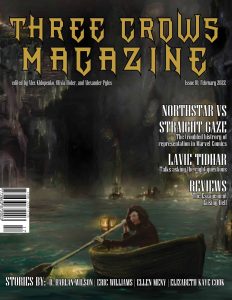 Three Crows, <threecrowsmagazine.com>, edited by Alex Khlopenko, published seven stories plus non-fiction in two online issues. Pay was $.01/word and $50 for art. [Semiprozine]
Three Crows, <threecrowsmagazine.com>, edited by Alex Khlopenko, published seven stories plus non-fiction in two online issues. Pay was $.01/word and $50 for art. [Semiprozine]
New Myths, <newmyths.com>, published 30 short stories plus poems and non-fiction in three issues. Editor Susan Shell Winston said, ‘‘In the fall we redesigned our website for a brand new look. To do so, we needed to combine our fall and winter issues into one giant issue that came out in December. We will be publishing our third anthology Neosapiens this summer, and editing our fourth anthology The Cosmic Muse for publication early next year.’’ There were around 500 visitors on the site/month. Pay was 1.5 cents/word, minimum of $30. [Semiprozine]
Bards and Sages Quarterly, <www.bardsandsages.com>, published 31 short stories, including three reprints, in four online issues. Pay was $30 for original fiction, $15 for reprints. [Semiprozine]
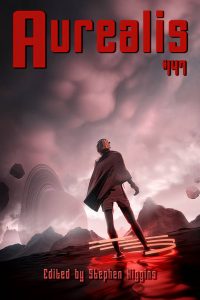 Australian Aurealis, <aurealis.com.au>, published 30 original stories in ten online issues. Editor Dirk Strasser said, ‘‘We see ourselves as a world magazine and would like to see more submissions from outside US/UK/Australia/New Zealand during our anyone/anywhere submission window in July. The editors have wide-ranging tastes, so we have published the gamut of fantasy, science fiction and horror throughout 2021.’’ Pay rate was A$.02/word. Parent company Chimaera Publications also ran the Aurealis Awards. [Semiprozine]
Australian Aurealis, <aurealis.com.au>, published 30 original stories in ten online issues. Editor Dirk Strasser said, ‘‘We see ourselves as a world magazine and would like to see more submissions from outside US/UK/Australia/New Zealand during our anyone/anywhere submission window in July. The editors have wide-ranging tastes, so we have published the gamut of fantasy, science fiction and horror throughout 2021.’’ Pay rate was A$.02/word. Parent company Chimaera Publications also ran the Aurealis Awards. [Semiprozine]
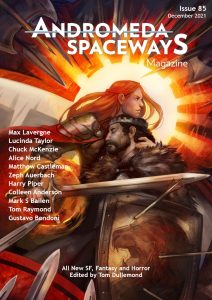 Australian Andromeda Spaceways <andromedaspaceways.com>, published four online issues with 43 stories (one reprint) plus poems. ‘‘We’ve always published a mix of speculative fiction (including horror) and comedic pieces. As we cycle through our members who enjoy editing, each issue can have a significantly different tone.’’ Pay for short fiction was A$.01/word up to 10,000 words and A$10 for poetry. [Semiprozine]
Australian Andromeda Spaceways <andromedaspaceways.com>, published four online issues with 43 stories (one reprint) plus poems. ‘‘We’ve always published a mix of speculative fiction (including horror) and comedic pieces. As we cycle through our members who enjoy editing, each issue can have a significantly different tone.’’ Pay for short fiction was A$.01/word up to 10,000 words and A$10 for poetry. [Semiprozine]
Kaleidotrope, <www.kaleidotrope.net>, a quarterly, published 30 original stories in four online issues plus poetry. Editor Fred Coppersmith said, ‘‘There were so many great stories, and it was wonderful to see when they connected with readers and reviewers. It was delightful, for instance, to see Andrea Tang’s ‘Portrait of a Pinup Boy at the End of the World’… make the 2020 Locus Recommended Reading List at the start of [2021].’’ The site had 3,000-4,000 unique visitors a month. Pay was $.01/word, $5 for poetry, $60 for artwork. [Semiprozine]
Heroic Fantasy Quarterly, <www.heroicfantasyquarterly.com>, published 14 short stories (one reprint) plus poetry in four scheduled online issues. Editor Adrian Simmons said, ‘‘We always enjoy finding new writers, and think that Gregory Mele’s bronze-age/Meso-America tales are a great find, and we’ve had established authors Darrel Schweitzer and Adrian Cole find homes in our ezine this year.’’ There were about 1,000 uniques per month with about 39,000 hits per month. Pay was $100 for fiction, $25 for poems, with some variation based on length. [Semiprozine]
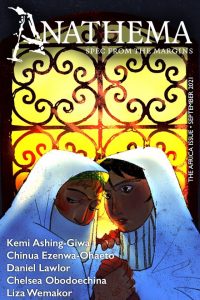 Anathema, <www.anathemamag.com>, focusing on ‘‘weird, slipstream, surrealism, fabulism, and more by queer people of colour on every range of the LGBTQIA spectrum,’’ published 14 original stories plus poetry in three scheduled online issues. Editor was Michael Matheson. ‘‘We always love seeing but get fairly few quieter stories like slice of life pieces or slow build romances, and every (generally infrequent) experimental piece is an absolute joy to see in the reading queue.’’ Pay was C$150 for fiction, C$75 for poetry, and C$300 for cover art. There were 1,000 uniques/month, 225 subscriptions. [Semiprozine]
Anathema, <www.anathemamag.com>, focusing on ‘‘weird, slipstream, surrealism, fabulism, and more by queer people of colour on every range of the LGBTQIA spectrum,’’ published 14 original stories plus poetry in three scheduled online issues. Editor was Michael Matheson. ‘‘We always love seeing but get fairly few quieter stories like slice of life pieces or slow build romances, and every (generally infrequent) experimental piece is an absolute joy to see in the reading queue.’’ Pay was C$150 for fiction, C$75 for poetry, and C$300 for cover art. There were 1,000 uniques/month, 225 subscriptions. [Semiprozine]
 The Future Fire, <futurefire.net>, a quarterly magazine of progressive, feminist, queer, eco, multicultural, and cyberpunk fiction published four issues with 18 stories (short and novelette length) and poetry. Editor Djibril al-Ayad said, ‘‘The stories that got the most page visits, positive reviews, social media shout-outs, etc. were without exception countercultural and underdog stories, with explicit queer, disability and neuro-atypical content. This is pleasing, and we’d love to see even more of it, because (a) it’s a set of content we like as well, and (b) it’s sometimes hard to judge and buy such content from different marginalisations than we experience, and we seem to be doing at least something right.’’ There was an average of 1,260 uniques/month. Pay was $20 for fiction. [Semiprozine]
The Future Fire, <futurefire.net>, a quarterly magazine of progressive, feminist, queer, eco, multicultural, and cyberpunk fiction published four issues with 18 stories (short and novelette length) and poetry. Editor Djibril al-Ayad said, ‘‘The stories that got the most page visits, positive reviews, social media shout-outs, etc. were without exception countercultural and underdog stories, with explicit queer, disability and neuro-atypical content. This is pleasing, and we’d love to see even more of it, because (a) it’s a set of content we like as well, and (b) it’s sometimes hard to judge and buy such content from different marginalisations than we experience, and we seem to be doing at least something right.’’ There was an average of 1,260 uniques/month. Pay was $20 for fiction. [Semiprozine]
 Metaphorosis, <magazine.metaphorosis.com>, a monthly print and digital venue for ‘‘intelligent, beautifully written stories for adults’’ published 12 issues with 49 original stories, including one serialized novella. Print issues were an unusual miniature-format 10 x 15 cm with glossy color covers and good-quality art. Editor B. Morris Allen said, ‘‘One of our serialized novellas was a Nebula Award finalist in 2021, which was fun. A reader tweeted recently that ‘right now I am feeling @MetaphorosisMag for the consistent beauty of their stories,’ and that’s exactly what we’re aiming for.’’ There was an average of 2,000 visitors/month. Stories were available free on the website or $8.00/print on Amazon, $4.00/ebook. Pay was $0.01/word. [Semiprozine]
Metaphorosis, <magazine.metaphorosis.com>, a monthly print and digital venue for ‘‘intelligent, beautifully written stories for adults’’ published 12 issues with 49 original stories, including one serialized novella. Print issues were an unusual miniature-format 10 x 15 cm with glossy color covers and good-quality art. Editor B. Morris Allen said, ‘‘One of our serialized novellas was a Nebula Award finalist in 2021, which was fun. A reader tweeted recently that ‘right now I am feeling @MetaphorosisMag for the consistent beauty of their stories,’ and that’s exactly what we’re aiming for.’’ There was an average of 2,000 visitors/month. Stories were available free on the website or $8.00/print on Amazon, $4.00/ebook. Pay was $0.01/word. [Semiprozine]
Speculative City, <speculativecity.com>, ‘‘embraces the motivations of speculative fiction and integrates them into a focus of setting: the city.’’ An online literary spec-fic magazine, they published seven original stories and two poems in two issues. Meera Velu is editor-in-chief. Pay was $20-$55 depending on length, up to 5,500 words for fiction. [Semiprozine]
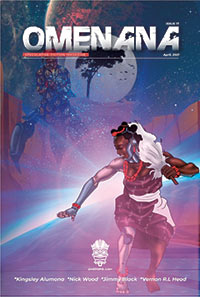 Omenana, <omenana.com>, speculative fiction ‘‘from across Africa and the African Diaspora,’’ published 33 original stories in four free online issues. Co-founder and managing editor Chiagozie Nwonwu said, ‘‘We started a collaboration with Mame Diene to serve Francophone writers and it has been a great experience. For 2022 we hope to keep doing what we are doing and hopefully upscale and create more visibility for the magazine and the writers we feature. We also hope that the French angle can grow enough to become a standalone sister magazine. We saw more science fiction and African Futurism this year than in previous years. We are hoping that we will see more next year as more writers are embracing the genre.’’
Omenana, <omenana.com>, speculative fiction ‘‘from across Africa and the African Diaspora,’’ published 33 original stories in four free online issues. Co-founder and managing editor Chiagozie Nwonwu said, ‘‘We started a collaboration with Mame Diene to serve Francophone writers and it has been a great experience. For 2022 we hope to keep doing what we are doing and hopefully upscale and create more visibility for the magazine and the writers we feature. We also hope that the French angle can grow enough to become a standalone sister magazine. We saw more science fiction and African Futurism this year than in previous years. We are hoping that we will see more next year as more writers are embracing the genre.’’
 Lackington’s, <lackingtons.com>, published two scheduled online issues with 14 stories, edited by Ranylt Richildis. Pay was C$.01/word, $25 minimum, and C$25-C$40 for artwork. [Semiprozine]
Lackington’s, <lackingtons.com>, published two scheduled online issues with 14 stories, edited by Ranylt Richildis. Pay was C$.01/word, $25 minimum, and C$25-C$40 for artwork. [Semiprozine]
Underland Arcana, <www.underlandarcana.com>, produced four issues, 13 x 18 cm with matte color covers and b&w interiors, 119-135 pages, with 38 original short stories of ‘‘the numinous, the esoteric, the supernatural, and the weird’’. Editor Mark Teppo said, ‘‘Arcana is still in the early stages of finding its audience, and in that respect, 2021 was a fine start. I’m hoping to grow awareness during 2022 by continuing the same devotion to atmosphere and excellence that went into 2021.’’ There were about 1,500 hits/month and ten subscribers. Free online, or $9.99-$12.99/print, $2.99/ebook. Pay rate was $0.01/word. [Semiprozine]
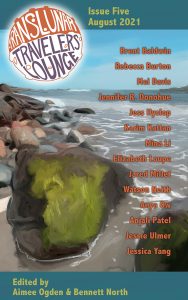
Translunar Travelers Lounge, <translunartravelerslounge.com> edited by Aimee Ogden & Bennett North, published 28 original stories in two online issues. Pay was $.03/word with a $20 minimum. ‘‘We were delighted to get to work with some of our past authors for a second time: Vanessa Fogg, Anya Ow, and Mina Li. For issue 6, we’ve got an exciting slate of new, as well as new-to-us, authors who have a terrific slate of stories running the gamut from humor to heartbreak to hope.’’ Visitors/month fluctuates, averaging about 1,000 uniques. [Semiprozine]
Non-profit Electric Spec, <www.electricspec.com>, published four scheduled electronic issues with 22 original stories. Editors were Nikki Baird, Lesley L. Smith & Grayson Towler. Pay was $20/story. [Semiprozine]
Little Blue Marble, <littlebluemarble.ca>, published and edited by Katrina Archer, published 17 original stories, four reprints, and four poems online. ‘‘We published a record number of debut authors this year (4), which is almost a quarter of our original fiction.’’ Pay was $.08/word. They had uniques of 455/month. [Semiprozine]
 Three-Lobed Burning Eye, <www.3lobedmag.com>, edited by Andrew S. Fuller, published 12 original and 46 reprint stories in two online issues and two print anthologies, saying, ‘‘It was a busy year. We read ~3,700 stories to select 12…. Two settings we enjoy, undersea goings on and in a nearby forest stories seemed to be popular in the reading queue stories, but makes it all the more challenging to choose stories right for 3LBE. Just like the global temperature, stories about climate are rising – and they should be. We are seeing more submissions from BIPOC and LGBTQIA+ voices, and would like to read more and more.’’ They had 1,200 visitors/month, 200 ebook purchases/year, and 500 newsletter subscribers. $100/short story, $30/flash fiction. [Semiprozine]
Three-Lobed Burning Eye, <www.3lobedmag.com>, edited by Andrew S. Fuller, published 12 original and 46 reprint stories in two online issues and two print anthologies, saying, ‘‘It was a busy year. We read ~3,700 stories to select 12…. Two settings we enjoy, undersea goings on and in a nearby forest stories seemed to be popular in the reading queue stories, but makes it all the more challenging to choose stories right for 3LBE. Just like the global temperature, stories about climate are rising – and they should be. We are seeing more submissions from BIPOC and LGBTQIA+ voices, and would like to read more and more.’’ They had 1,200 visitors/month, 200 ebook purchases/year, and 500 newsletter subscribers. $100/short story, $30/flash fiction. [Semiprozine]
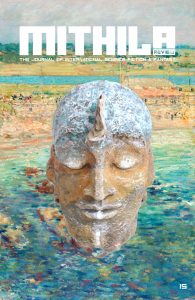 Mithila, <mithilareview.com>, published one online issue with 7 original stories, from flash to novella length. Editor Salik Shah said, ‘‘We are on hiatus at the moment. We’re considering a special issue sponsored by an organization.’’ Pay was $10.00. [Semiprozine]
Mithila, <mithilareview.com>, published one online issue with 7 original stories, from flash to novella length. Editor Salik Shah said, ‘‘We are on hiatus at the moment. We’re considering a special issue sponsored by an organization.’’ Pay was $10.00. [Semiprozine]
There was one digital issue of Neo-opsis, <www.neo-opsis.ca>, with six stories and some non-fiction. Editor was Karl Johanson. According to Johanson, ‘‘Neo-opsis has had a YouTube channel for more than a decade: <www.youtube.com/user/KarlJohanson42>. We’ve added a TikTok page in 2021, which hit more than 60,000 views in a couple months: <www.tiktok.com/@neoopsissciencefiction>.’’ There were 150 subscribers. Cover price was C$5.00. Fiction pay rate was C$.025/word, capping at $125. [Semiprozine]
 There was one double issue of Alien Dimensions, <aliendimensions.com>, perfect bound, 15 x 23 cm, 200 pages, with a glossy color cover and b&w interior, including 14 short stories and three pieces of flash fiction. The magazine was available in ebook and POD. Editor Neil A. Hogan said, ‘‘I’d like to see more high tech, hard science, space fiction stories. Even COVID isn’t stopping this decade from being the new golden age of science fiction!’’ Print cover price was $12.95, ebook $4.99, or free with subscription to Kindle Unlimited. Pay rate was $10 per story. [Semiprozine]
There was one double issue of Alien Dimensions, <aliendimensions.com>, perfect bound, 15 x 23 cm, 200 pages, with a glossy color cover and b&w interior, including 14 short stories and three pieces of flash fiction. The magazine was available in ebook and POD. Editor Neil A. Hogan said, ‘‘I’d like to see more high tech, hard science, space fiction stories. Even COVID isn’t stopping this decade from being the new golden age of science fiction!’’ Print cover price was $12.95, ebook $4.99, or free with subscription to Kindle Unlimited. Pay rate was $10 per story. [Semiprozine]
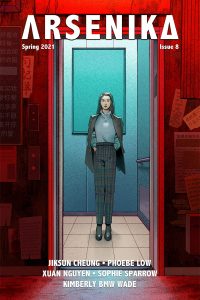 Arsenika, <arsenika.ink>, edited by S. Qiouyi Lu, published two original stories and three poems in one issue online. Pay was $60 for flash, $30 for poetry. ‘‘Arsenika’s final issue was #8…. Quite proud of the work published in issue 8! I’ve always tried to provide a space for experimental work with Arsenika and the last issue has quite a bit of it.’’ [Semiprozine]
Arsenika, <arsenika.ink>, edited by S. Qiouyi Lu, published two original stories and three poems in one issue online. Pay was $60 for flash, $30 for poetry. ‘‘Arsenika’s final issue was #8…. Quite proud of the work published in issue 8! I’ve always tried to provide a space for experimental work with Arsenika and the last issue has quite a bit of it.’’ [Semiprozine]
There were 12 issues of Smith’s Monthly, which resumed this year after a three-year hiatus, <www.smithsmonthly.com>, with work solely by Dean Wesley Smith, 130-190 pages, perfect-bound with glossy color covers and b&w interiors, and 90 pieces of fiction, 52 original, 38 reprint. Cover price was $12.99. [Semiprozine]
We saw three issues of Planet Scumm, <www.planetscumm.space> with 27 stories available electronically and in print, 14.5 x 21 cm with matte color covers and b&w interiors, 90-147 pages. Editor-in-chief was Sean Clancy. Managing editor Tyler Berd said, ‘‘It was a year for the haunting and strange both inside our mag and out in the world. We’ll still want a similar blend of exciting pulp and thought-provoking concepts, but there is talk of a mystery-focused issue at some point in our future.’’ Average unique visitors per month was 500-1000, hits 1,000-1,500, with 30 subscribers. Total print sales were around 200, with pricing at $12.00-$14.00/print, $10.00/ebook. Most recent pay rate was $0.04/word. [Semiprozine]
We saw issues #2 and #3 of the twice-yearly Weird Horror <www.undertowpublications.com>, ‘‘new and startling original horror fiction…. Long live the new pulp!’’ Available in print and electronically with 18 pieces of short fiction, 18 x 25 cm with glossy color covers and b&w interiors. Editor was Michael Kelly. Pay rate was $0.01-$0.05/word. [Semiprozine]
 Constelación, <www.constelacionmagazine.com>, ‘‘born out of two people who had the same dream: to read more speculative stories in Spanish,’’ edited by Coral Alejandra Moore & Eliana González Ugarte, produced two issues with 14 stories, along with non-fiction. Pay rate was $.08/word up to 6,400 words.
Constelación, <www.constelacionmagazine.com>, ‘‘born out of two people who had the same dream: to read more speculative stories in Spanish,’’ edited by Coral Alejandra Moore & Eliana González Ugarte, produced two issues with 14 stories, along with non-fiction. Pay rate was $.08/word up to 6,400 words.
In poetry, we received three issues of Dreams & Nightmares, <www.dreamsandnightmaresmagazine.com>, priced at $5.00 (less for subscribers) with 51 original poems. Editor was David C. Kopaska-Merkel. Pay rate was $12/poem. [Semiprozine]
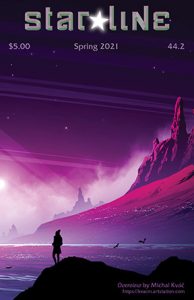 Star*Line, <www.sfpoetry.com/starline.html>, the journal of the Science Fiction and Fantasy Poetry Association, produced four issues priced at $5.00, with 326 original poems, available in print and PDF. There were 425 subscribers print and digital combined. Print run was 320 copies/issue. Pay rate was $.03/word, minimum $3.00. F.J. Bergmann returned as editor pro tempore for two issues, and Jean-Paul L. Garnier came on board as editor starting with issue 44.3. Garnier said, ‘‘We receive a lot of horror and fantasy poems, I would love to see more science fiction poetry.’’ The SFPA also published 83 poems in Eye to the Telescope, a quarterly online speculative poetry journal with a different theme and editor each issue, <www.eyetothetelescope.com>. [Semiprozine]
Star*Line, <www.sfpoetry.com/starline.html>, the journal of the Science Fiction and Fantasy Poetry Association, produced four issues priced at $5.00, with 326 original poems, available in print and PDF. There were 425 subscribers print and digital combined. Print run was 320 copies/issue. Pay rate was $.03/word, minimum $3.00. F.J. Bergmann returned as editor pro tempore for two issues, and Jean-Paul L. Garnier came on board as editor starting with issue 44.3. Garnier said, ‘‘We receive a lot of horror and fantasy poems, I would love to see more science fiction poetry.’’ The SFPA also published 83 poems in Eye to the Telescope, a quarterly online speculative poetry journal with a different theme and editor each issue, <www.eyetothetelescope.com>. [Semiprozine]
For print, we also saw four issues of Boundary Shock Quarterly; three issues of Conjunctions; two of Vastarien; and one each of Weirdbook; Penumbra; and Chosen Realities, the new journal of the Diverse Writers and Artists of Speculative Fiction. New pro-rate venue Departure Mirror, edited by Arthur Robert Tracy IV, published two issues in 2021 before permanently closing. In online mags, we did not see any issues of Phantom Drift, Amazing Stories, or Curiosities, but one issue was apparently available in print and digital formats. For digital, Galactic Suburbia has closed, and there were no issues from Terraform this year.
PODCASTS
AUDIO FICTION
Marguerite Kenner, COO of Escape Artists, Inc., said about Escape Pod: ‘‘For reasons no one will wonder about, the tone of submitted stories took a darker turn this year. Our goal is to skew fun or positive in our published stories, and it became harder and harder to find good stories with the right tone. We are very happy to announce that we brought Premee Mohamed onto staff as assistant editor to help out Ben Kinney.’’ On PodCastle: ‘‘We were nominated for a Hugo, an Ignyte, and an Aurora Award. Our former co-editors Jen R. Albert and Cherae Clark stepped down, and Shingai Njeri Kagunda and Eleanor R. Wood took over.’’ On Cast of Wonders: ‘‘Our Young Author submissions call resulted in four stories being accepted from teen writers – look out for these in 2022! Next summer, the Cast of Wonders flash fiction competition returns.’’ All four markets pay $0.08/word for original fiction, $100/story for reprints, and $20/flash fiction reprint. [Semiprozine]
There were 52 episodes of Escape Pod, <www.escapepod.org>, ‘‘The Science Fiction Podcast Magazine,’’ with 45 stories. PodCastle, <www.podcastle.org>, produced 57 episodes with 61 fantasy stories. PseudoPod, <www.pseudopod.org>, ‘‘the sound of horror,’’ produced 54 episodes with 69 stories. Cast of Wonders <www.castofwonders.org> published 40 episodes with 45 stories. [Semiprozine]
StarShipSofa, <www.starshipsofa.com>, produced and hosted by Tony C. Smith, published 25 episodes with 25 stories. Pay was $50/story. [Semiprozine]
Tales to Terrify, <talestoterrify.com>, owned and hosted by Drew Sebesteny and edited by Seth Williams, published 102 stories in podcast format, ‘‘68% original, 32% reprint,’’ in 52 episodes. Sebesteny said, ‘‘2021 was a landmark year for the podcast. We published our 500th episode and also were able to generate enough consistent revenue to begin compensating staff and narrators for the first time in our history. 2022 makes 10 years of the show.’’ Average downloads per month was 55,000 with pay $0.01 USD/word. [Semiprozine]
Drabblecast, <www.drabblecast.org>, ‘‘off-beat, funny, eclecticism in science fiction, fantasy, and horror,’’ hosted, produced, and narrated by Norm Sherman, published 16 stories in 16 episodes. Pay was $.06/word for original fiction and $.03/word for reprint fiction.
FANCASTS
Jennifer Mace, Freya Marske & Alexandra Rowland produced 23 episodes of Be the Serpent <betheserpent.podbean.com> ‘‘about everything from academic mythology to dick jokes (and sometimes, both at once).’’ Mace said, ‘‘We announced an indefinite hiatus from our 100th episode (posted December 3rd) onwards.’’ Downloads averaged 2,000 per episode. [Fancast]
Michelle Graham & Giles Hash co-hosted Beyond the Trope, <beyondthetrope.com>, publishing 50 episodes. ‘‘In 2021 we adjusted our format to return to our discussion roots, releasing two interviews in a row then a discussion episode….’’ Interviews included Andy Weir, Laurell K. Hamilton, and Lemony Snicket. Average downloads per month was 5,000. [Fancast]
The Coode Street Podcast, <jonathanstrahan.podbean.com>, with hosts Jonathan Strahan & Gary K. Wolfe, returned to a biweekly schedule in 2021, publishing 27 episodes, one of them a special thank you episode after receiving the Hugo Award. Wolfe said: ‘‘Some of our favorite guests included John Clute, Aliette de Bodard, Veronica Schanoes, Kelly Robson, P. Djèlí Clark, Sarah Pinsker, Nghi Vo, Daryl Gregory, Zen Cho, Catherynne M. Valente, Lavie Tidhar, M. Rickert, Arkady Martine, Oghenechovwe Donald Ekpeki, Sheree Renée Thomas, and a year-end roundup with James Bradley, Alix E. Harrow, and Ian Mond.’’ Downloads ranged from 1,100-1,500 per episode. [Fancast]
Fangirl Happy Hour, <www.fangirlhappyhour.com>, ‘‘on the intersections of fandom, literature, and culture,’’ produced five episodes in 2021, with interviews and reviews. Hosts are Ana & Renay, co-editors of The Book Smugglers and Lady Business, respectively. [Fancast]
Functional Nerds, <www.functionalnerds.com>, posted 46 episodes focusing on SF/F media. Patrick Hester said, ‘‘2021 was a rough year. My mother died in March…. For several weeks as mom’s health declined and I took care of her, Tracy had to host on her own – and she did a fantastic job. Even with that challenge (or in spite of it?), we stuck to our schedule and celebrated our 500th episode in July.’’ Guests included Cat Rambo, Becky Chambers, Peter F. Hamilton, Ellen Datlow, Andy Weir and, for their 500th episode, Catherynne M. Valente. Episodes averaged 2,100 downloads each. [Fancast]
Geek’s Guide to the Galaxy, <geeksguideshow.com>, hosted by David Barr Kirtley and produced by John Joseph Adams. Kirtley said: ‘‘We released 48 episodes this year, once per week for January-November. In December I took my first vacation in 11 years. By far our most popular episode of the year was Tom Gerencer talking about his self-published short story collection Intergalactic Refrigerator Repairmen Seldom Carry Cash, which got almost 35,000 downloads. The most exciting guest this year was Brent Spiner, who played the android Lieutenant Commander Data on Star Trek: The Next Generation.’’ They had 20,000 unique visitors per month. [Related Work]
Our Opinions Are Correct, <www.ouropinionsarecorrect.com>, hosted by Charlie Jane Anders & Annalee Newitz, produced 24 episodes of deep dives into SF books, movies, television, and comics. ‘‘We feel like 2021 was our strongest year, content-wise, and we’ve worked hard to do more research and have tighter episodes.’’ They average 20,000 downloads per month. [Fancast]
The Skiffy and Fanty Show, <skiffyandfanty.com>, with hosts Shaun Duke & Brandon O’Brien, plus, after the departure of Jen Zink, a variety of co-hosts. They published 48 of 58 scheduled episodes. Interviews included P. Djèlí Clark and Cadwell Turnbull. Episodes averaged 1,400 downloads. [Fancast]
Writing Excuses, <www.writingexcuses.com>, produced 52 educational episodes by writers for writers. Hosted by ‘‘core cast’’ Margaret Dunlap, Mary Robinette Kowal, Mahtab Narisiman, Brandon Sanderson, Howard Tayler, and Dan Wells. ‘‘We switched to a MasterClass format this year with eight weeks focused on various aspects of different topics.’’ They saw 20,000 listeners per week. [Related Work]
CRITICAL MAGAZINES
There were three issues of scholarly journal Extrapolation, from Liverpool University Press, totaling 367 pages, with essays on colonization, women pulp writers, Tolkien and rape, AI rights, migrant workers, and more. Andrew Butler was managing editor. Print and PDF available at <online.liverpooluniversitypress.co.uk/loi/extr>. [Related Work]
There were three issues of academic journal Foundation, <www.sf-foundation.org/>. Editor Paul March-Russell said, ‘‘The journal highlight of the year was Foundation 139 on ‘decolonising SF’ with specially commissioned artwork from Sonya Dyer, interviews with Courttia Newland and John Rieder, essays by Isiah Lavender III and Vandana Singh, and articles from Europe, the Americas and Asia. We also celebrated the 50th anniversary of the Science Fiction Foundation at our online AGM…. We were also delighted that Susan Ang received her belated SFRA award for innovative scholarship for her article in 2019 on China Miéville. There is a planned change of editor in 2022 and are currently advertising for my successor.’’ Print runs are 260 copies, with a subscriber base of 230-250. [Related Work]
Kevin J. Maroney published one issue of The New York Review of Science Fiction <www.nyrsf.com/toc>, with 183 subscribers, and 80 daily website hits. Pay rate was $40 for features, $20 for reviews, and $10 for short features. Maroney said, ‘‘Samuel R. Delany’s ‘Racism and Science Fiction’ is still by a huge margin our most popular article…. 2021 felt like surgery without anesthesia every few weeks. I’m glad of the issue we did publish!’’ He hopes to have all of their back catalog available through Weightless Books by the end of the year along with POD editions of the last few years. [Semiprozine]
Scholarly journal Science Fiction Studies, <www.depauw.edu/sfs>, published three issues, edited by Arthur Evans. The magazine was available in print and digital with access through JSTOR, with new access via Project MUSE coming in 2022. They had approximately 600 subscribers. Size of each issue was around 200 pages, with an average print run of 400 copies. [Related Work]
Two issues of Wormwood, edited by Mark Valentine, were available from Tartarus Press, with critical works exploring the fantastic, supernatural, and decadent in literature <www.tartaruspress.com/wormwood.html>. Print run was 400. Cover price was £9.99. [Semiprozine]
There were two issues of Vector, <vector-bsfa.com>, the critical journal of the British Science Fiction Association, edited by Polina Levontin & Jo Lindsay Walton, with articles and reviews on SF in books, games, television, music, and film. Issue 293 was a special issue on Chinese SF/F guest-edited by Yen Ooi & Regina Kanyu Wang, with some articles translated into Chinese and published in World Science Fiction Frontiers. Issue 294 was a special issue on SF/F and Class guest-edited by Nick Hubble. Circulation was 750. The current open call for submissions is on the theme of SF/F and Libraries.
In 2021, we also saw two issues of Focus, the BSFA’s magazine for writers, edited by Dev Agarwal; four issues of the digital reviews ’zine BSFA Review, edited by Sue Oke; and the inaugural issue of the digital fiction anthology Fission, edited by Allen Stroud. Next year, the BSFA plans to publish 2-3 issues of Vector on themes including Greek SFF and SFF and Justice; two issues of Focus; one issue of Fission (to be edited by Eugen M. Bacon and Gene Rowe); and 3-4 issues of The BSFA Review. [Related Work]
One of four scheduled issues was published by the SFWA Bulletin, a digital journal available to SFWA members and Nebula Conference attendees. Editor-in-chief Michi Trota stepped down mid-year, and C.L. Clark left their post as editor of the SFWA Blog in December. SFWA executive director Kate Baker said, ‘‘The stress of the year not only impacted decisions on printing (we decided to elect an entirely online release due to paper shortages and our green initiative) but the overarching issues with the ongoing pandemic also affected publications staff and authors. The Bulletin continued to see excellent writing advice and strategies from authors from underrepresented and marginalized groups in #216, with authors such as Maurice Broaddus, K.S. Villoso, Karlyn Ruth Meyer, Yilin Wang, Tobias S. Buckell, Vida Cruz, Natalia Theodoridou, Khaalidah Muhammad-Ali, Sarah Gailey, and Sascha Stronach.’’ Pay was $.10/word.
QUALITY
Our gauge for quality is based on our short fiction Recommended Reading list; see chart. We recommended 126 pieces of short fiction from 2021, up from 124. One work, A Blessing of Unicorns by Elizabeth Bear, was published by both Audible Originals and Asimov’s and has been attributed to both publishers. Recommended stories appeared in 34 magazines or online venues, up from last year’s 25. Anthologies had seven recommended stories, down from last year’s 12, while there were three recommended stories from collections, down from last year’s four. Major anthologies were Black Stars with three stories, When Things Get Dark: Stories Inspired by Shirley Jackson with two, and The Gollancz Book of South Asian Science Fiction: Volume 2 and Sword Stone Table with one story each. Uncanny led the magazines/fiction sites with 15 stories, followed by F&SF with 14, Tor.com with 11, Clarkesworld with eight, and Apex, Asimov’s, Fiyah and Lightspeed with seven each. The remaining magazines had four or fewer recommended titles.
CONCLUSION
This year felt a lot like last year in some ways: we continued to see writers leaning into darker fiction, even though editors were still hoping for upbeat stories (but that definitely reflects the mood of the times); calls for more marginalized and international voices; stories about apocalypse, dystopia, and climate change; and the now-traditional request for more science fiction. And more SF poetry! Like last year, digital sales continue to up and print continues to go down. We loved some of the amazing cover art and saw venues playing with different formats. We also saw an abiding persistence in the field, magazines were fighting to hang in there, paying higher rates, reaching out to a diverse set of voices, trying out print, and upping their game all around.
Now for your annual reminder that most of these magazines make very little money, but really want to pay their staff and their contributors. So much work and heart go into all of these magazines, but they can’t survive without reader support. Even if the admission price to read is free, please take a moment to support the venues you enjoy, by subscribing, donating, advertising, and supporting!
This summary and more like it in the March 2021 issue of Locus.
 While you are here, please take a moment to support Locus with a one-time or recurring donation. We rely on reader donations to keep the magazine and site going, and would like to keep the site paywall free, but WE NEED YOUR FINANCIAL SUPPORT to continue quality coverage of the science fiction and fantasy field.
While you are here, please take a moment to support Locus with a one-time or recurring donation. We rely on reader donations to keep the magazine and site going, and would like to keep the site paywall free, but WE NEED YOUR FINANCIAL SUPPORT to continue quality coverage of the science fiction and fantasy field.
©Locus Magazine. Copyrighted material may not be republished without permission of LSFF.



